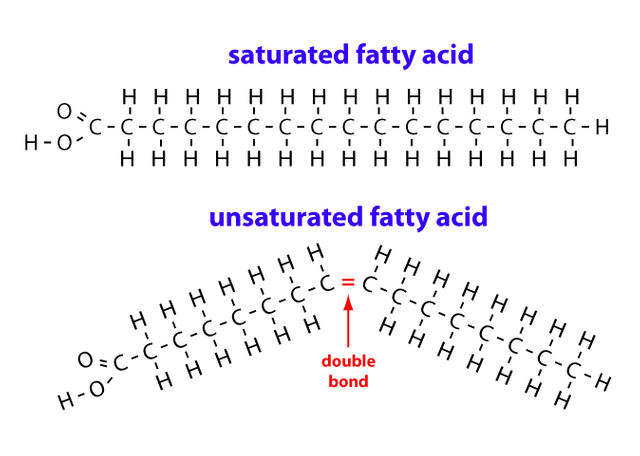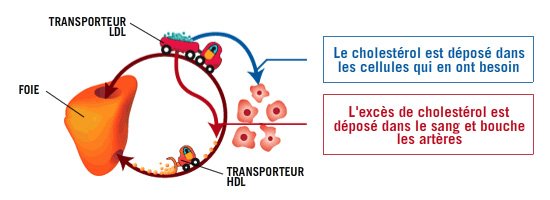The essential Lipids
Hello everyone!
For my very first article I decided to speak about an often pointed substance for his so-called “misdeeds”, I talk about the LIPIDS! Yes ! This vicious which is judged to cause cardiac diseases and to rove us in our bathing suits… Although I would agree, in excess AND for certain greases, it is responsible amoung others many pathologies, my objective is to explain :
- Which are good greases to be privileged
- Differences between the saturated and unsaturated fatty-acids, the omega 3 6 and 9, triglycerides and cholesterol
- The food to be consumed
Firstly I will speak about the Fatty-acids. It is the smallest unit of the lipids. They are divided into two categories: saturated fatty-acids and unsaturated fatty-acids. Perhaps you wonder in what they are saturated or unsaturated. Their differences is done on the molecular level. Without returning in detail, you just need to know a molecule of saturated fatty-acid “is saturated with hydrogen”.It means it's overbooked in hydrogen atom.
Vegetable oils containers much of saturated fatty-acid as the oil of coconut, palm or butter are presented in solid form to ambient temperature. They are ideal oils for cooking because they are very resistant to heat. Thus they do not oxidize and do not become toxic for the organism. However, they should be consumed with moderation to avoid these famous cardiovascular problems (plate of atheroma in the artery, hypertension arterial, tachycardia…).
The unsaturated fatty-acids, in contrary to saturated fatty-acids, contain double bonds between the carbon atoms. Oils are thus more fluid, beneficial for health, but are more sensitive and unstable with the light and heat. Moreover there are two sub categories:
- Unsaturated mono fatty-acids: the molecule has that only one double connection (Ex: olive oil)
- The unsaturated fatty-acids poly: the molecule has several double connection (ex: rapeseed oil, walnut, flax, hemp, soybean, germ of wheat…)
What it is necessary to know it is that the more there is double connection, the more oil will be fragile and beneficial for health. For the olive oil, you can make it heat at high temperature without making it “smoke”. One must preserve it safe from the light (to avoid oxidation) in a dry place and preserves 1 year. For rich oils on fatty-acids poly unsaturated it is FORBIDDEN to make it heat because that modifies their molecular structures (hydrogenation) and they lose all their properties. After opening it is necessary to put them at the fridge and to consume them in 3 months.

Thing which one often intends to speak in the pubs or the media are omega 3,6,9. Now that you know the fatty-acids, I will be able to talk about it.
Omega 3.6 make parties of the unsaturated fatty-acids. They are good for health.
Omega 9 is part of the fatty-acids mono-unsaturates (avocado, hazelnut, olive oil…). However it can be manufactured when necessary by the body (starting from glucids). It protect from cardiovascular system (cholesterol level LDL in blood drops, increases cholesterol HDL, stabilizes the glycemia at the diabétiques ones)
With regard to omega 6 and 3, they are known as “essential” because our body cannot manufacture them. They thus should be brought by food.
Omega 6 are brought by food of the vegetable kingdom and animal. The concern is that according to this food, they can have beneficial effects (action anti-inflammatory, reduction of allergies, reduction in of cardiovascular risks, hormonal regulation, calming nervous system, fights against the hyperactivity of children and fight against the addictions) as negative (increases the cardiovascular risks by supporting plate aggregation, increases the inflammatory processes and the allergies, inhibits the positive effects of omega 3 and 6). Yes I know, it is very contradictory all that! The reason is that, the food of the vegetable kingdom brings the positive effects: seeds and oils vegetable of sunflower, sesame, carthame, corn, soybean, onager, fresh borage, hemp, spiruline, almonds, eggs. But as from the moment when you consume too many fatty meats, of pork-butchery, butter and cheese, that will cancel all the advantages of the first (vegetable oils) AND will generate the toxic effects quoted above. Thus yes, the meat is a source of omega 6 but with strong amount problem poses.
As a result, today we consume much more omega 6 compared to omega 3. The ratio to follow to be in balance must be 5 omega 6 for 1 omega 3. Today it is on average of 30 omega 6 for 1 omega 3 and it is not without consequence. Despite everything, if it's your pleasure to eat a good piece of cheese or a rib steak, don't panic, you can continue but try to space their consumption and get QUALITY ! Privilege local products and organic if possible, that will cost you less money if you buy it in the producer and the taste is incomparable vis-a-vis the industrial food of supermarket. And even if it's more expensive, that will limit you a little in consumption; -)
For omega 3, you can consume it as many as you pleased to! They increase the rate of “good cholesterol” (HDL) in blood, reduced the triglycerides, reduction of the Blood-pressure at the hypertensive ones, prevention of the formation of the plate of atheroma in the arteries, they are necessary to the good performance of the brain because it composed of approximately 60% of lipids of the fatty-acid omega 3, it stimulates the lipolysis (it makes us lose weight!) and it has properties anti-inflammatory. One advises it for the people suffering from depression or anxiety. The pregnant women must be encouraged to consume some for the good development of the foetus.
To give you an order of idea on rich foods in omega 3:
- Seeds and vegetable oils of colza, flax (it consists of 50% of omega 3), walnut, hemp
- Fatty fishes (or fish oil): tuna, salmon, mackerel, sardine, liver of cod (privilege small fishes as much as possible which is charged in heavy metals)
However there is certain food which facilitates its assimilation better: the fatty fishes undoubtedly make it possible to have its contributions in omega 3. The oil of hemp, from its composition, also makes it possible to be quite comparable (but it is rather expensive). You can always continue to consume rapeseed oil, of flax, dodder and walnut in your salads, but one should not be confronted with certain limiting factors (intense stress, chemotherapy and radiotherapy, anaesthesia…). It is thus necessary to combine the vegetable and animal sources, to consume fatty fishes 2 times per weeks (the canned fish can get the bargain).
Other lipids which it is with my opinion important to understand are cholesterol HDL (good cholesterol) and cholesterol LDL (bad cholesterol). One tends to simplify while saying good or bad cholesterol, but both are necessary, they are complementary. They have a role of transport, they are presented in the form of blister making of the return tickets between the cells and the liver.
The role of the LDL is to transport certain lipidic substances to the cells (soluble vitamins A, D, E, K, triglycerides and cholesterol). One can imagine them like buses transporting these substances of the liver towards the cells. The cells need these nutriments for functioning well. It should be known that cholesterol is present naturally in the membrane of the cells, in our skin (the cholesterol of our skin is the precursor of the vitamin D, that means without it one cannot manufacture our vitamin D and that on the long run can cause an osseous demineralization and a bad assimilation of calcium), in our brain in great quantity (white substance), it allows the formation of the bile in the gall bladder (the bile makes it possible to digest and emulsify the food fats which arrive of the stomach). One also speaks about endogenous cholesterol, menning the liver manufactures 80% of cholesterol, and 20% come from the food. In this case it is exogenic (oil, egg yolk, meat, offal…). I do not advise either to make food containers ultra restrictive modes of cholesterol because if you are in deficiency, the liver will compensate for this lack and will be tired. To return from there with the LDL, it is named “bad cholesterol” because while taking along all these substances to the cells, it goes from this fact “of clogging” our fabrics. The Problem actually it is when they are present in too great quantity because the cells recover only the nutrients for which they have needs. As a result if there are too much cholesterol and triglyceride compared to the needs for the cells, the LDL will stagnate in the blood-vessels, they will oxidize and they will not be recognizable any more by the cells. For this reason they tend to clog our organization and to form plates of atheromas in the arteries.
The HDL, called “good cholesterol” has as a role to bring back cholesterol, triglycerides and the vitamins A D E K which are not used by the cells towards the liver where they will be stored. As a result it makes possible “to clean” the blood-vessels. However, even if this mechanism is practical, it is not a reason to eat fatty at will. It is necessary to keep a balance between HDL and LDL. If there is more LDL than of HDL that will overload your organization. I return from there to famous omega 9 (olive oil) and omega 3 (colza, flax…) who allows to increase the rate of HDL in blood.

Pay attention to the drugs which lower blood cholesterol, because they cause in many cases disorders of the memory, a bad synthesis of the vitamin D etc… I am not anti drug but if you suffer from hypercholesterolemy, work initially on your food and see if that is enough.
Thank you for reading, I hope ou enjoyed it, stay tuned for the next article!
Celia.
😯 ★good post!!!; 😯
thanks ! see you soon :-)
this is one incredible post . sorry I missed it